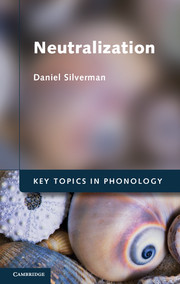Book contents
- Frontmatter
- Contents
- List of Figures
- Preface
- Acknowledgments
- 1 The rhyme and the reason of neutralization
- Part I Rhyme
- Section A Observation and description
- Section B False positives
- Section C Explanation
- Section D Exemplification
- 12 Case study
- 13 Domains of application
- 14 “Distinctions are drawn that matter”
- Part II Reason
- Glossary
- References
- Language index
- Subject index
12 - Case study
Published online by Cambridge University Press: 05 November 2012
- Frontmatter
- Contents
- List of Figures
- Preface
- Acknowledgments
- 1 The rhyme and the reason of neutralization
- Part I Rhyme
- Section A Observation and description
- Section B False positives
- Section C Explanation
- Section D Exemplification
- 12 Case study
- 13 Domains of application
- 14 “Distinctions are drawn that matter”
- Part II Reason
- Glossary
- References
- Language index
- Subject index
Summary
We have reached the point in our discussion of neutralization – or, more to the point, neutralization; neutralization as derived homophony – to test our predictions against a body of data. Recall that neutralization involves limitations on the distribution of phonetic information, limitations that possess genuinely function-negative consequences. Assuming that language structure and language change are influenced by functional considerations, there may exist passive diachronic pressures against the proliferation of homophone-deriving alternations. Thus, recall from Chapter 1 my overarching proposal: alternations are more likely to be present in a language if they do not significantly increase the level of homophony; derived homophony is not excessive.
A particularly rigorous testing ground for these predictions would involve a pattern or patterns of sound change that do significantly increase the amount of (traditionally defined) neutralization. The proposal would be that, in such cases, despite an overall decrease in word-internal phonetic distinctions, evidence for semantic distinctions emerges largely intact, as derived homophony remains negligible. In this chapter then, we report on a single case study: neutralization in Korean (Silverman 2010, Kaplan 2011a). Indeed, it emerges that despite this language's huge amount of traditionally defined neutralizing alternation, the amount of derived homophony resulting from such alternations – that is, the amount of neutralization – is surprisingly meager.
- Type
- Chapter
- Information
- Neutralization , pp. 130 - 139Publisher: Cambridge University PressPrint publication year: 2012

